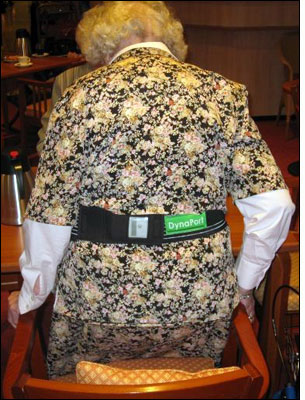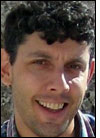A group consisting of European universities and hospitals, led by Italian researchers at the University of Bologna, are developing a wireless sensor system that they say addresses the needs of both athletes and the elderly. The group recently completed a review of a proof-of-concept study involving wireless sensors to help athletes improve their performance, as well as assist the elderly by tracking their activities and alerting caregivers if they fall. During the past six months, the researchers have been analyzing the pilot’s results, in order to determine how effectively the system accomplished what it was intended to do. Now, the team hopes to generate support and funding for a more extensive pilot, with the intention of developing a commercially available solution.
The system, known as SENSing and ACTION to support mobility in Ambient Assisted Living (SensAction AAL), centers on wireless sensors designed to track a wearer’s movements. Data related to those movements can then either be stored on the unit itself, transmitted to a PDA that provides audio feedback indicating whether the user is moving properly, or transmitted to a PC that makes the information accessible to a caregiver or emergency authority, via the Internet.
These applications were tested in the 30-month, EU-funded pilot, which began in January 2007 and concluded in summer 2009, led by two groups of researchers at the University of Bologna. A biomedical engineering team designed the system’s ability to measure posture and movement, and also developed algorithms for biofeedback-oriented physical training, while the second group—the microelectronics team—focused on designing the system, which uses off-the-shelf hardware. To measure and record a person’s movements and body posture, the group chose a small device supplied by McRoberts, a Dutch manufacturer of mobility sensors. The device, which contains gyroscopes, accelerometers and a rechargeable lithium polymer battery that typically provides 75 hours of usage, measures approximately 8 centimeters by 4 centimeters (3.1 inches by 1.6 inches) in size, and attaches to an elastic belt worn around the waist.
To transmit data, the sensor unit is wired to a Bluetooth or ZigBee transmitter that communicates with a PDA or a personal computer located in the room with the patient or athlete. The Bluetooth transmitter, known as the Hybrid Dynaport, was provided by McRoberts, while the ZigBee transmitter used STMicroelectronics‘ MotionBee technology. “Recently, many ZigBee-based technology vendors are providing adaptors for personal computers and USB-enabled devices,” says Lorenzo Chiari, the university’s SensAction-AAL project coordinator. This makes ZigBee a competitive alternative to Bluetooth, he indicates. With ZigBee, he adds, a patient could wear multiple networked sensors that could all talk to the PDA or PC.
The EU-funded project is intended to address health-care problems for an aging worldwide population, but the technology was piloted for physical therapy programs for athletes, the injured or the elderly.
The pilot included using the sensor data in three ways: In one case, a user could receive biofeedback, an application that would most commonly be utilized in physical therapy or sports training. In that case, the sensors measured the user’s movements and transmitted that data to a PDA via a Bluetooth or ZigBee connection. The PDA received that information and used software developed by the SensAction-AAL researchers, to determine the individual’s position and compare that with the appropriate position thresholds (such as the angle at which he should be performing a specific exercise), thereby determining whether those movements are appropriate for the activity or physical exercise the system is programmed to monitor, or if they need to be modified.
If, for example, someone was utilizing the system as an aid to physical therapy, the sensor software could determine when that individual had leaned too far forward, or not far enough, and instruct that person to change position. This could be accomplished with a voice recording, or could be done in conjunction with music on the PDA. If the person were listening to music while exercising, for instance, the music could fade in or out, depending on that person’s body position. Whether the system used Bluetooth or ZigBee, the user would need to be within about 10 meters (33 feet) of the PDA, meaning the device would need to be located in the same room as the individual in an indoor setting.
In the second scenario, the sensor was treated as a recording tool, simply tracking movements over a period of time and storing that data to be downloaded later by a caregiver. In the third scenario, information was transmitted to a PDA and then sent on to a remote location, such as a caregiver’s server, via the Internet. This not only provided the caregiver with real-time details regarding the patient’s status, it could also send an alert if that individual fell and then failed to get back to his or her feet. If a patient were to fall and not stand up, the software in the sensor unit would send an alert to the PDA, which would then pass that alert on to a server, either via Bluetooth or ZigBee.
The wireless transmission portion of the trial was conducted on approximately 20 elderly individuals at the University of Groningen in the Netherlands, at the Robert-Bosch-Krankenhaus research hospital in Germany, and at the Tel-Aviv Sourasky Medical Center in Israel. Some pilot participants were in a hospital setting, while others took the devices home and were monitored via the wireless communication technology.
Users were enthusiastic about the system, Chiari says. There were about 30 falls during that time, he notes, which were detected by the system and properly transmitted to the appropriate caregivers. Since the pilot’s conclusion, Chiari adds, researchers have been studying the results, which show that the system works properly and is ready for broader use. “It’s our belief that these kinds of tools offer an advantage. Even the users themselves offered very positive feedback; they recognized that it was a support, and not a cumbersome technology,” he says, indicating that the small form factor made the sensor easy to wear and to use. “We are now looking to do a larger clinical study,” he states, in Europe, North America or both.
If the group can conduct a larger pilot and obtain the interest of commercial technology providers, Chiari indicates, the system could offer the health-care industry the ability to provide tele-rehabilitation (training and physical therapy), tele-monitoring (storing data regarding a wearer’s movements) and tele-care (sending fall data to caregivers). In this way, he says, a caregiver would not be solely reliant on the personal recollections of patients (or their family members) regarding the types of activities that were done, the kinds of falls that may have occurred and whether a patient’s movements have been hindered by an injury or illness.
The researchers estimate that the remote monitoring system would cost around €25 ($35) weekly for each patient if used for 20 weeks, since a unit combining the sensors and transmitter would retail for approximately €2,500.



